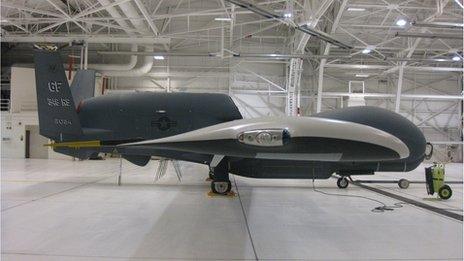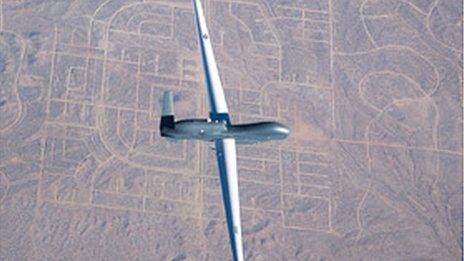Drones: A rare glimpse at sophisticated US spy plane
- Published

The unarmed face of intelligence surveillance and reconnaissance gathering
The Global Hawk is one of the US military's most sophisticated spy planes and the BBC was able to get a rare view of one at Grand Forks Airbase in North Dakota.
It can travel halfway round the world on a single tank of fuel and can track a man on the ground, even when the earth is covered by cloud, from a height of about 18,000m - that's close to 60,000ft.
That means it could in theory peer into Syria to track chemical weapons while still flying in international airspace. Or keep track of North Korea's nuclear programme flying from the Pacific island of Guam.

At Grand Forks airbase, some staff remove their name badges to avoid being identified
The man in charge of operations at Grand Forks, Colonel Lawrence Spinetta, says the Hawk "spans the globe on a daily basis, 24-7, providing some great intelligence for senior decision makers", though he won't be drawn on details.
Land of drones
The use of drones, or Remotely Piloted Aircraft, as the US Military prefers to call them, is highly controversial, not least because of the clandestine killings carried out by armed CIA drones, such as the Reaper and Predator.
Some Americans are worried about the way drones can be used to carry out surveillance at home; 17 US states have passed laws limiting their use.
But North Dakota, which is sparsely populated and has wide-open empty spaces, appears more relaxed.
The University of North Dakota is one of the first in the US to offer a degree course in how to operate drones.
While the Global Hawk is not armed there is still a lot of secrecy surrounding its use.
At Grand Forks airbase, there is still little sign that the US military is about to lift the lid.
The crew of the United States Air Force (USAF) even remove their name badges to avoid identification.
We were asked to leave any recording devices, cameras or phones behind as we were shown one of the "shelters" from which the Global Hawk is flown.
Outside it looks like a shipping container. Inside, there are banks of screens, though for this visit they had all been switched off.
The Operations Room, which oversees missions, is firmly out of bounds behind a heavy door with a secure entry code.
Flying from home
We are, however, allowed to witness a pilot carry out a simulated mission from his desk.
One of the pilots admits he misses what he calls the "seat-of-the-pants feeling" you get while in the air. He says "it's not as exciting as flying a manned aircraft", but adds that it is rewarding in other ways.
The aircrew speak positively about being able to fly missions anywhere in the world without leaving the comforts of home or the family behind.

The Global Hawk can survey an entire country
That is perhaps one reason why a pilot can feel "a little detached", even if he or she is totally focused on the mission.
But these unmanned aircraft are the future.
The Nato alliance doesn't usually purchase its own military hardware but its members have clubbed together to buy five Global Hawks at a cost of $1.7bn (1.2bn euros).
By 2017 they will be flying out of Sigonella in Sicily with the potential to cover maritime security as well as supporting troops on the ground.
More than military tool
Those who manufacture drones are keen to highlight their utility beyond the battlefield.
Bob Zeiser, who helps run the Global Hawk programme at Northrop Grumman, says the Global Hawk has been involved in helping out in the aftermath of natural disasters.
In 2010, one flew over Haiti following a devastating earthquake, where it mapped the devastation and helped direct rescue efforts. It was able to conduct the mission from California and survey the entire country three times before returning to base.
More recently, a Global Hawk was used to assess the damage to the Fukushima nuclear plant in Japan.
Mr Zeiser acknowledges there's still a challenge in winning around the public, but he says the negative perceptions can be overcome by showing the public that drones are safe to fly and that they are a good way of keeping people out of harm's way.
But there are still plenty of questions as to how drones can be safely integrated into civilian airspace and how the rest of us feel about being watched by an unblinking eye in the sky.
- Published31 January 2012
- Published14 October 2013
- Published24 October 2013
- Published27 September 2013